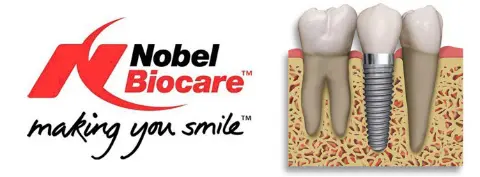Dental Implants
If you lose one or more teeth due to periodontal disease, or another cause, there is hope. Dental implants are changing the way people live! They are designed to provide a foundation for replacement teeth that look, feel, and function like natural teeth. The person who has lost teeth regains the ability to eat virtually anything and can smile with confidence, knowing that teeth appear natural and that facial contours will be preserved. Patients with dental implants can smile with confidence.

What are Dental Implants?
Dental implants are designed to provide a foundation for replacement teeth that look, feel, and function like natural teeth. The person who has lost teeth regains the ability to eat virtually anything and can smile with confidence, knowing that teeth appear natural and that facial contours will be preserved. The implants themselves are tiny titanium posts that are surgically placed into the jawbone where teeth are missing. These metal anchors act as tooth root substitutes. The bone bonds with the titanium, creating a strong foundation for artificial teeth. Small posts that protrude through the gums are then attached to the implant. These posts provide stable anchors for artificial replacement teeth. Dental Implants also help preserve facial structure, preventing the bone deterioration that occurs when teeth are missing.
Evaluation
If, like many others, you feel implant dentistry is the choice for you, we ask that you undergo a dental/radiographic examination and health history. During these consultation visits, Dr. Swart will address your specific needs and considerations. Your questions and concerns are important to us and our team will work with you very closely to help make your procedure a success. We will also discuss fees and insurance at this time. There are many types of insurance plans, and coverage for implants is varied. We will be happy to assist you in obtaining any benefits to which you may be entitled.
The Surgical Procedure
For most patients, the placement of dental implants involves one surgical procedure. First, implants are placed within your jawbone. Healing time following surgery varies from person to person and is based on a variety of factors, such as hardness of bone. In some cases, implants may be restored immediately after they are placed. After the implant has bonded to the jawbone, the second phase begins. An impression will be taken of the implants. The teeth replacements are then made by our dental technician.
What Types of Prosthesis are Available?
A single prosthesis (crown) is used to replace one missing tooth – each prosthetic tooth attaches to its own implant. A partial prosthesis (fixed bridge) can replace two or more teeth and may require only two or three implants. A complete dental prosthesis (fixed bridge) replaces all the teeth in your upper or lower jaw. The number of implants varies depending upon which type of complete prosthesis (removable or fixed) is recommended. A removable prosthesis (over denture) is secured with attachments, whereas a fixed prosthesis is permanent and removable only by a professional. Dr. Swart has received extensive training in Dental Implantology. Through continuing education, Dr. Swart is abreast of the most current information on implant dentistry. At the moment all our dental implants are placed with the PRP (Platelet Rich Plasma) technique, to stimulate the healing of the gums and bone.





